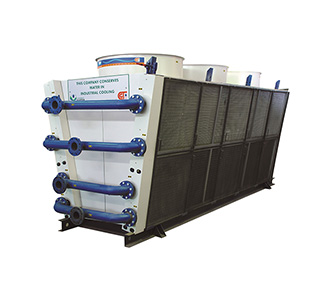FUNCTION & FEATURE:
DRY COOLING TOWER is an equipment which is used to cool and maintain the temperature of process hot water at a particular level. This operates on the principle of heat transfer by a hear exchanger with extended fins. The fan is driven by an Electric motor.
Copper Tubes:
The best quality imported (5/8") OD copper tubes in Level Wound Coils are used. This ensure coils with the minimum number of joints by forming a hair pin bends as well as to form a uniform wall thickness that eliminates embarrassing and expensive leaks after installation. Tubes are staggered in the path of airflow for better heat transfer efficiency.
Return Bends:
They are die-formed from thick walled tubing that is heavier than the standard tubing used in the rest of the coils. This provides the toughness and durability required in the most vital parts of the coils.
Headers
Inlet and outlet headers are constructed of heavy wall steel pipes with shoulders formed at each brazed connection to the 5/8" tube in the coil. This shoulders intruded with special tooling provides the strength to the brazed joint that eliminates another source of leak during transit and installation.
Mechanical Tube Expansion
Tubes are Mechanically expanded for an optium bond between tube and fin. This positive and controlled expansion procedure provides a clean, smooth inner tube surface for allow water pressure drop and guarantees uniform heat transfer between tube.
Heat Transfer Coils:
Improved Circuiting:
The GEM Cooling Tower Design of water circuiting provides flexibility in selection and unequaled performance optimization. All inlet and outlet connections are provided on the same end thus reducing expensive piping and installation costs.
Rigid Construction:
A die formed galvanized steel frame provides stacking and shipping support and protection against tube damage during expansion and installation.
Venting, Draining and Expansion Tank:
Each water duty coil is provided with a convenient vent connection at the highest point and a drain connection at the lowest point apart from a small expansion tank.
Pressure Testing:
Each coil is pressure tested after manufacture, by air under water at 300 psi for water application.
Computerized Selection:
Speeds up and simplify the selection of right coil for your specific requirement.
CONSTRUCTION AND OPERATION:
Dry Cooling Tower is mounted on a heavy duty channel base frame. Non corrosive fibre glass / GI panels are used for enclosure. Aero dynamically balanced high efficiency axial flow fans with low noise are used.
The motors are IP 55 class with extended SS shaft. The low speed of the motor minimises noise and increases efficiency. Motors are specially designed to withstand moisture, rain and dust.
The hot water from the diesel engine is sent to the inlet of the Dry Cooling Tower. This hot water is cooled and cold water from the outlet of the cooling tower is connected to a pump which pumps the water to the diesel engine (or any other load) to pick up the heat from the generator.
COMPARISON CHART
| Dry Cooling Tower | Evaporative Cooling Tower and Heat Exchanger |
| No water consumption. | Huge loss of water due to evaporation, drift, spray loss and blow down. |
| No preparation is required for atmospheric air is available in plenty. | Water is scarce. Bringing water to site is expensive. Water has to be treated before use. |
| No scale formation. No cleaning of Heat Exchanger | Scale formation is unavoidable. Frequent cleaning is required leading to high down time and expensive labour |
| No moving parts except fan and motors - negligible maintenance | Maintenance is required on a day to day basis. V belts, bearings blocks, Pump couplings, Sprinkler nozzles has to be cleaned |
| No mixing of dust, dirt, fly ash or living organisms with process water | Water exposed to dust and dirt will be contaminated. Fungus formation and living organisms will foul heat exchanger which require cleaning |
| No restriction on plant location | Water source decides the location of large plants |
| No corrosions due to air | Steel parts in contact with water are corroded |






